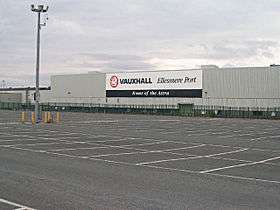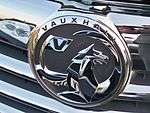Vauxhall Ellesmere Port
 | |
| Built | 1962 |
|---|---|
| Location | Ellesmere Port, Cheshire, England |
| Coordinates | 53°17′52.71″N 2°56′10.37″W / 53.2979750°N 2.9362139°W |
| Industry | Motor vehicle manufacture |
| Products |
Vauxhall Viva (1962–1974) Opel/Vauxhall Chevette (1975–1980) Opel/Vauxhall Astra (1981–present) |
| Employees | 2,100 |
| Area | 1,209,366 m2 |
| Volume | 187,000 vehicles |
Vauxhall Ellesmere Port is a motor vehicle assembly plant, located in the town of Ellesmere Port, south of the Wirral Peninsula in Cheshire, England.
Background
In 1070, William the Conqueror granted the lands of Hooton adjoining the River Mersey to Adam de Aldithly. Eventually they passed to the Stanley family through a series of marriages. After the Battle of Bosworth, Hooton had a new hall and the first Lord Derby in Lancashire. A second half-timbered hall was built in 1488.
A third Italian-style hall was constructed circa 1778, but this later sold to cover the Stanley family’s gambling debts in 1850. The hall was bought by a Mr. Naylor, a wealthy Liverpool banker, for 82,000 guineas. He spent a further 50,000 guineas on the addition of a 100 feet (30 m) tower, an art gallery, and a large dining hall. He also built a racecourse, polo ground, heronry, stud farm and a church in Childer Thornton in memory of his first wife. His yacht was moored on the Mersey, but in the 1890s the construction of the Manchester Ship Canal cut off his access, so he moved to another of his properties in Nottinghamshire. To avoid paying rates the hall was emptied of contents and staff but the estate continued to be farmed whilst the racecourse and polo ground remained in use.
RAF Hooton Park
British participation in World War I was declared on 4 August 1914, and Hooton Park’s racecourse was used for the last time some ten days later. The British War Department then requisitioned the estate for use as an army training ground. The hall became a headquarters, hospital, and officers’ mess. Lord Derby recruited the first Pals regiments, and Hooton became the training ground for the 18th Battalion of the Kings Liverpool Rifles. They left for France, and fought in the Battle of the Somme on 1 July 1916.
Allocating the site to the Royal Flying Corps as a training aerodrome for pilots, the War Department built one single and three double aircraft hangars, which were completed in 1917. These hangars had a unique latticed timber roof construction – Belfast Trusses - which were originally used in the Belfast shipyards to cover large working areas and which provided strength at low cost.
During the early/mid-1930s, it was one of the two airfields (with Liverpool Speke) handling scheduled services for the Merseyside region. Hooton Park was home to No. 610 (County of Chester) Squadron and, post World War II, to No. 611 (West Lancashire) and No. 663 (AOP) Squadron.[1]
The airfield closed in 1957 after the disbandment of the Royal Auxiliary Air Force, with the site sold to Vauxhall Motors. The small remaining section of the airfield site is now owned and managed by The Hooton Park Trust. The three pairs of Belfast Truss hangars, erected in 1917, survived the closure, and today are GradeII* listed buildings. Presently the hangars are home to The Griffin Trust, 610 (County of Chester) Squadron Association, an aircraft preservation society named The Aeroplane Collection.
History
The former RAF site was bought by Vauxhall Motors, who developed their plant as a sub-assembly and engine production centre to supply their existing Dunstable and Luton factories. The first plant director, American Tom Williams, was already familiar with the site from his days as a World War II pilot in the US Air Force. The first components flowed off the production line in November 1962.[2]
However, the site was quickly developed as the small-car production centre, with the first Vauxhall Viva HA model rolling off of the new assembly line in June 1964. What became known locally as the North Road factory has been responsible since for building all of the successive models, including from 1975 all variants of the Vauxhall Chevette. Employment at the plant peaked that year, at 12,000.[2]
In 1980, the plant exported the first Opel badged cars from the UK, with 2,000 Ellesmere Port-built Chevettes exported for sale in West Germany through the Opel dealer network.[2] After the launch of the Vauxhall Astra in 1981, a further £65M investment in 1984 allowed commencement of the second generation Astra. After the consolidation of the European management, design functions and vehicle models in 1986 of the Opel and Vauxhall companies under parent company General Motors Europe, over half of the production output of the plant has been exported.[2]
For much of its existence thereon within the Opel/Vauxhall production network, Ellesmere Port has been the sister facility to Opel's Bochum plant in Germany; from the 1973 Opel Kadett C onward, the two factories have been the lead plants for the Kadett/Astra platform through the last six model generations. Following Bochum's closure in 2014, Ellesmere Port will become the sole lead plant for the Astra K, which expected to be released in 2016.
In 1996, it was the first car plant in the world to be certified for its environmental management systems.[2]
Current vehicle built at Ellesmere Port
Opel/Vauxhall Astra (1981 - present)
Former cars built at Ellesmere Port
Vauxhall Viva (1963 - 1979)
Opel/Vauxhall Chevette (1975 - 1984)
Opel/Vauxhall Vectra (1995 - 2008)
Opel Kadett/Vauxhall Astra (1979 - 1991)
Opel Kadett Combo/Bedford Astramax/Vauxhall Astramax (1986 - 1994)
Present
Today the plant employs circa 2,200 people, still producing the current model Opel/Vauxhall Astra.[2]
There had been fears that the plant could close in 2014, as the new Astra model comes into production in 2015. However, compared to its sister site, Bochum, Ellesmere Port in 2012 was reported to be producing 47 cars an hour over two shifts a day (a company record), while Bochum was producing 30 cars an hour over three shifts a day. In May 2012 the announcement was made that as a result of its superior productivity Ellesmere Port had won the contract to produce the new Astra from 2015 alongside Opel's Gliwice (Poland) plant, securing the existing 2,100 jobs and adding a further 700 jobs to allow for a 51 week/3 shift production pattern.[3]
Football club
Vauxhall Motors F.C. was founded in 1963, shortly after the opening of the new plant. Early in its history, it played in the Ellesmere Port League and the Wirral Combination, but it soon grew too strong for those leagues. By 1970, the club had achieved several promotions and played on the company-owned Hooton Park. In 1987 it opened its own ground at Rivacre Park, opened by then England manager Bobby Robson, where the club plays today.
See also
References
| Wikimedia Commons has media related to Vauxhall Motors plant, Ellesmere Port. |
External links
- Vauxhall Ellesmere Port at DMOZ
- Vauxhall UK official website
- Ellesmere Port Plant. Facts and Figures
Coordinates: 53°18′11.9″N 2°55′55.3″W / 53.303306°N 2.932028°W

